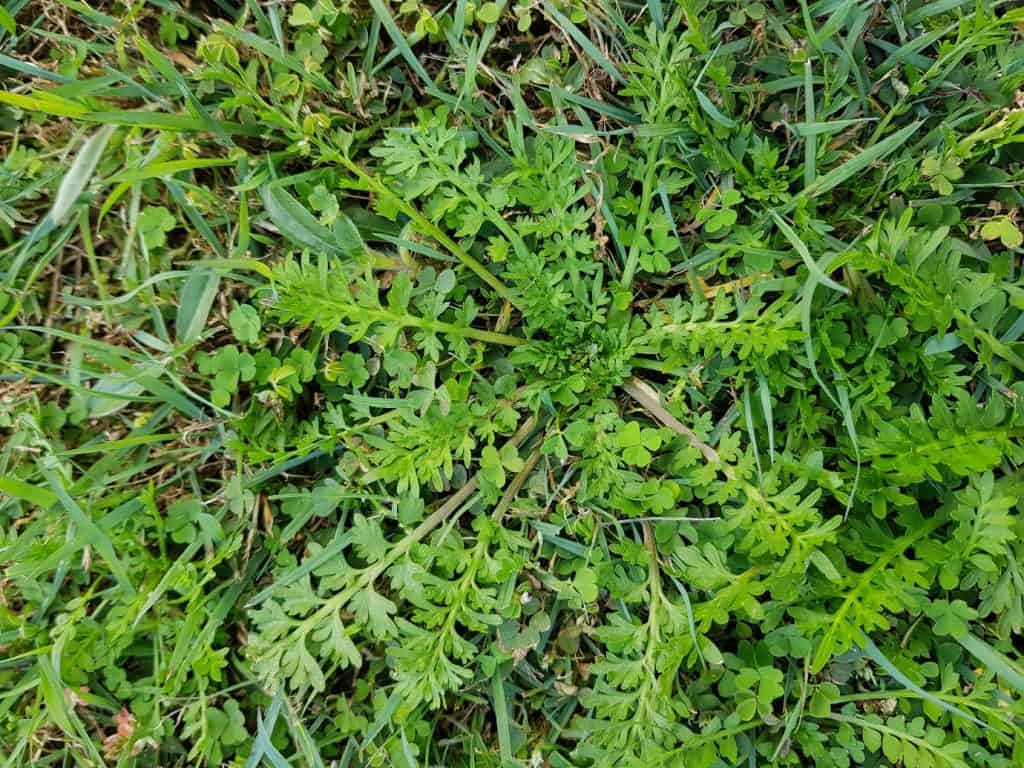How To Get Rid Of Bindis
Bindi (soliva sessilis) is a lawn weed that came from South America and is now common throughout Australia.

Bindi is a low mat-like weed that is distinguished by its feathery, parsley like leaves.
In the winter it appears to be harmless enough but during the spring and summer it develops prickly seed pods which dry and harden.
These seed pods become a really painful nuisance especially when you most want to enjoy your lawn and those summer barbeques in bare feet.
The seed pods can also cause problems for pets and get caught in their paws and fur which then transfer the seeds to other locations, where a new bindi infestation will take root.
Bindi weeds can infest any type of turf or lawn including Sir Walter Buffalo, Kikuyu, Palmetto, and Zoysia.
Prevention Is The Best Cure
As with so many weeds, bindis are opportunists.
They’re more likely to take over your lawn if you cut the lawn too short or scalp it allowing the bindis space to grow and out-compete your turf grass. Prevention is the best way of dealing with bindi weeds.
It’s especially important to keep your lawn a little longer during the winter months preventing bindis becoming established in the first place.
Unfortunately if you are trying to catch the see heads on Wintergrass then you may have to make a choice between Bindii or Wintergrass.
Because bindi grows so low to the ground mowing with a lower blade will not remove bindi flower or seed heads.
The bindi weed also thrives in hard compacted soil so we recommend that you aerate the soil from time to time with our specially designed aerator sandals, or on large areas hire an aerator and aerate the whole lawn.
These spiked sandals will break up the hard soil, allow the turf to breathe more easily, and make growing conditions a little less palatable for bindi weeds.
If your lawn gets a lot of heavy traffic and hard wear and tear then you’ll want to aerate the soil more frequently.
A bindi weed infestation may also be a sign of poor soil nutrition.
But don’t rush out and feed your lawn if the bindi weed has already appeared—you’ll be encouraging the bindi to grow even faster.
March and April are good times to apply fertilisers to keep your lawn healthy.
Check out our range of superior fertilizers including liquid seaweed as well as nitrogen, potassium, and phosphorous based lawn fertilisers.
Oxafert is good fertiliser and pre-emergent herbicide to use on warm season turf grass lawns.
It is recommended for Wintergrass, Summer grass and Crab grass weeds. It may have some benefits in suppressing Bindii but it may be better controlled with a post emergent herbicide in late Winter.
How To Get Rid Of Bindi Weeds Infestation?
If you have only a small lawn area and you catch the bindi problem early enough then weeding by hand may be a really effective solution.
Make sure you remove all the root material. If you’ve already got a bindi infestation on your hands (or feet) then spraying is your best option.
There are excellent commercial herbicides that will target bindi weeds without harming your valuable turf.
Amgrow Bin-die is a broad spectrum weed killer designed for use specifically with Buffalo varieties but it’s also perfectly safe to use on couch, kikuyu, fescue and rye lawns.
When Is The Best Time To Spray For Bindi?
August or early spring is a great time to spray for bindi weeds (bindi eye, bindii) if you’re using Amgrow Bin-die or Amgrow Buffalo Lawn Weeder.
Make sure you spray after leaves have formed but before seed heads have appeared.
Spot spraying may miss bindi weeds that are still emerging so it’s advisable to blanket spray any infected areas.
If the bindi has already flowered then you will need to use a different kind of spray such as those containing dimethylamine.
But always read the label before spraying as some of these weed killers will kill specific types of grass including Buffalo.
Are There Any Natural Bindi Weeds Sprays?
One home remedy that may work is a solution of iron sulphate. Use 2 tablespoons of iron sulphate to 4.5 litres of water and spray on to affected areas.
As always with natural remedies you need to exercise real caution as these products have not been tested.
Commercial sprays have undergone significant and rigorous testing in the laboratory and in the field so we know they’re safe for your turf when used as per the label directions.
However, chemical herbicides also have their dangers.
Please read and follow all the manufacturer’s instructions when using any herbicide and wear protective clothing including gloves when handling any chemicals or poisons.
Boiling water will also kill bindi but be very careful as it will also kill surrounding grass.
Be Bindi free this summer and enjoy your Atlas Turf the way it’s meant to be enjoyed.



